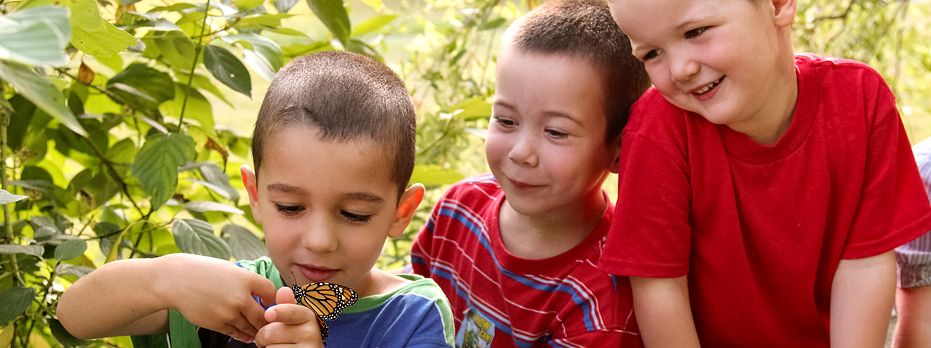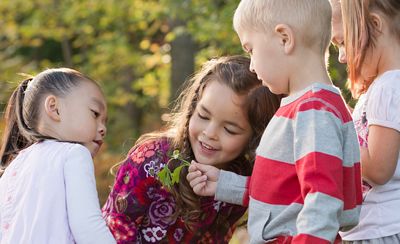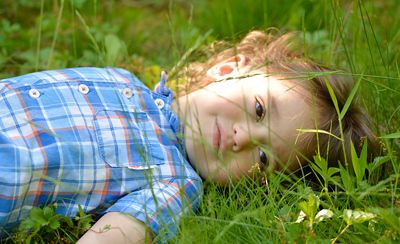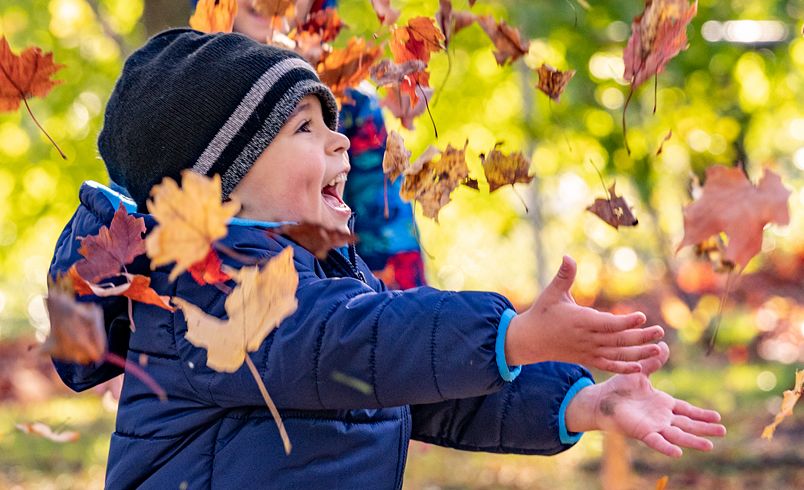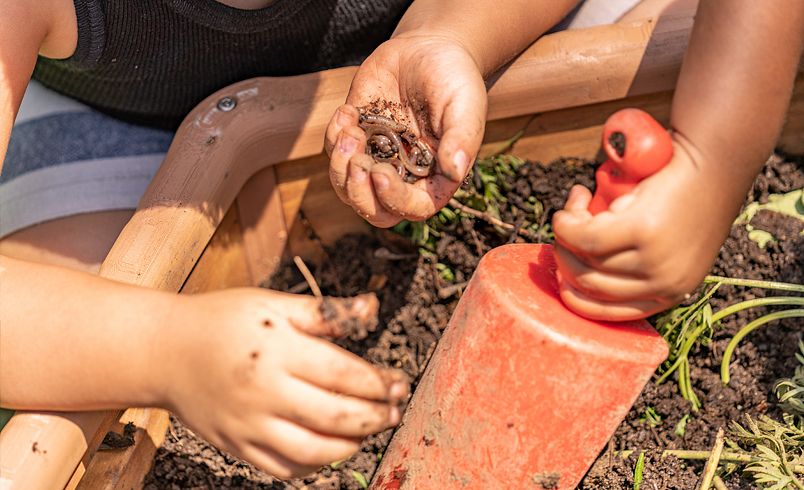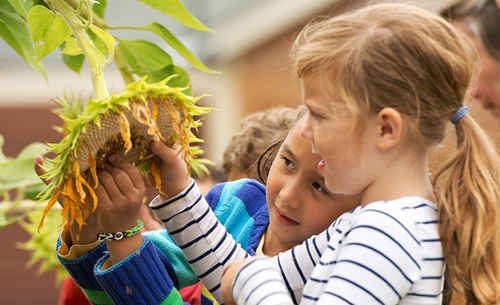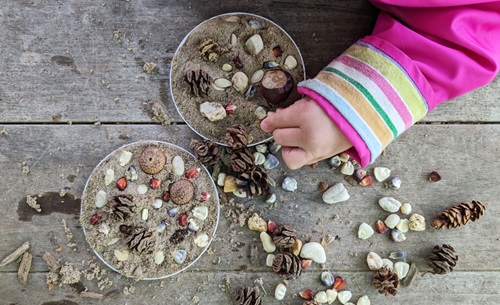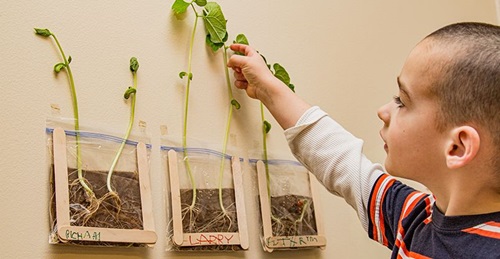Beyond Science: Connecting Children to Nature
| October 2015There’s little doubt in the minds of many educators that the natural world is a great place to learn science. Nature provides almost endless opportunities for observing, exploring, and experimenting—all important skills related to scientific inquiry and scientific ways of knowing.
It would be a mistake, however, to assume that science is the only academic area enhanced by nature explorations. Nature is a wonderful resource for other areas of early learning including literacy, math, and social studies. We also know that the benefits of nature for children go far beyond academic learning. With more time in nature children experience increased physical fitness, more inclusive and imaginative play, an improved sense of well-being, and higher self-esteem.
Some educators and parents assume that connecting children with nature is all about “saving the Earth.” While we want young children to know that Earth is our home and that it’s important to respect and care for the environment, it’s not appropriate to give them the burden of saving it. In fact, telling young children about frightening environmental issues can do more harm than good in fostering a positive relationship with nature.
The term “early childhood environmental education” has been misunderstood since it first appeared in professional literature in the early 1990s. Misguided questions still arise such as “will children be learning the sources of energy?” or “will this be a program about recycling?”
Education for Sustainability
This doesn’t mean that environmental education at the early childhood level is of little importance when it comes to sustainability. A recent report by UNESCO (United Nations Educational, Scientific, and Cultural Organization) indicates the opposite. This report, “The Contribution of Early Childhood Education to a Sustainable Society,” clearly describes how the understandings, attitudes, values, and habits acquired during the early years can have a long-lasting impact on children, society, and the natural environment. The report calls for a “new kind of education” that recognizes the important place early childhood education has “in the efforts to bring about sustainable development” (UNESCO 2008, 8).
Education for Holistic Development
While connecting young children with nature is important for sustainability, we should also be aware of other related benefits pertaining to the holistic development of young children. We know that children need more than knowledge and facts to become whole or to reach their potential as human beings. They also need a sense of purpose, positive self-identity, wonder, and joy. This component includes a concern for the larger whole and is expressed in such humanitarian or altruistic values as compassion, caring, and peace. We can foster both the personal and social aspects of holistic development by helping young children develop strong connections to each other, to the community, and to the natural world. Altruism and compassion play an integral role in establishing such connections.
A mistaken view some people have about young children is that their whole focus is on self and that they aren’t capable of being concerned about others. Research, however, tells us that even infants and toddlers can be compassionate and caring. We can support this important area of holistic development by modeling caring behaviors, narrating our actions, and engaging children in helping others. An example of narrating in this context is describing what you’re doing when you are helping someone: “Alexa is trying to push the wagon, but it’s stuck on the stones. I’ll go over there and help her.” In this example, you could also engage another child by saying: “Tony, would you come with me to help Alexa?” Children’s caring behaviors can also be narrated as a way to call attention to and reinforce what they’re doing: “Max is being very gentle with our pet bunny. I know the bunny likes that.”
Acknowledging children’s expressions of concern is another way to promote caring. A child might express concern for a butterfly with a broken wing or a bird nest that has fallen out of a tree. While you won’t be able to fix the problem for the butterfly or bird, your attention to the child’s concern reinforces a sense of caring.
In our efforts to connect children with nature, we shouldn’t overlook the “natural connection” or “goodness of fit” between children and nature (Wilson 2010, 2012). We base this thinking, in part, on what the scientist, E.O. Wilson (1984) refers to as “biophilia”–that is a genetically-based attraction to other living things. According to Wilson, we have a built-in need to seek connections with the rest of life. Without these connections, we cannot be whole.
It’s obvious from the many questions children ask and from their eagerness to explore and experiment that they are curious about nature and the way it works. We recognize such expressions of curiosity as being important to early science learning. But it’s more than that. Consider such questions as “What happens when the bird dies?” or “Why should we be gentle with animals?” Engaging children in a thoughtful discussion about such philosophical and ethical questions is another way to foster caring and to help young children develop a positive relationship with nature.
It isn’t always necessary to be scientifically accurate in how we respond to children’s observations and questions. In fact, it would be a mistake to overlook or discourage children’s special way of seeing the world. One child, looking back at the trees as the class left a park, remarked, “The leaves are waving good-bye.” At this point, there was no need for the teacher to give a lesson on differences between plants and humans or to explain that the leaves on the trees could not have conscious intent to communicate with the children. The teacher’s creative response was to encourage the children to wave back. This response probably did more toward fostering an emotional connection with the trees than what a scientific explanation could do.
Additional Concerns
So why aren’t teachers doing more to connect children with nature? The idea that nature needs to be an “add on” is false. Nature can be an integrating context or the medium through which all other curricular areas can be taught.
Another concern expressed by some teachers is that they don’t know enough about nature to teach it to children or to answer children’s questions about nature. Again, this should be a non-concern. Young children need experiences with nature far more than they need facts about nature. Rachel Carson (1956), in The Sense of Wonder, addresses this concern: “I sincerely believe that for the child and for the parent [or teacher] seeking to guide him, it is not half so important to know as to feel” (45).
An additional misconception held by some teachers is the belief that you need to “take the children to nature.” In their minds, this means taking a field trip. While it’s sadly true that some schools have very little to offer in the way of a natural environment, the fact that nature is everywhere should not be overlooked. A puddle of water in a parking lot, a few stones near a driveway, a spider’s web by the window, even the sky which is always and everywhere present—these are elements of nature.
Simple Ways to Foster Connections with Nature
Of course, we would love for all children to have richer experiences with nature, and there are many simple and inexpensive ways to enrich even the most barren environment. Plant some seeds in a bucket of soil. Use the saucer of a plastic flower pot to make a bird bath. Use sticks to make markings in the dirt. Hang short strips of yarn on the branches of trees during nesting season for the birds. Grow a sweet potato vine in a jar of water. Start a compost pile. Hang a windsock. Collect rain in plastic buckets. Add a variety of loose parts to the children’s outdoor play area. Loose parts are play materials that can be manipulated, changed, and moved about. Natural materials—such as stones, sticks, leaves, pine cones, etc.—make excellent loose parts. If these materials aren’t naturally available in the school yard, they can be brought in from other places.
Summary
So, yes, nature can be used to teach science; but there are also many other benefits to connecting children with nature. The natural world is a rich resource for promoting all areas of children’s holistic development and for sowing the seeds of a more sustainable future.
References
Carson. R. 1956. The Sense of Wonder. NY: Harper & Row.
UNESCO 2008. “The Contribution of Early Childhood Education to a Sustainable Society.” Accessed online August 25, 2015. http://unesdoc.unesco.org/images/0015/001593/159355E.pdflending.
Wilson, E.O. 1984. Biophilia. Cambridge, MA: Harvard University Press.
Wilson, E.O. 1992. The Diversity of Life. Cambridge, MA: Harvard University Press.
Wilson, R. 2010. “Goodness of fit: Good for children and good for the Earth.” The Earth is our Home edited by J.L. Hoot and J. Szente, 17-35 Olney, MD: Association for Childhood Education International.
Wilson, R. 2012. Nature and Young Children. 2nd edition. NY: Routledge.

